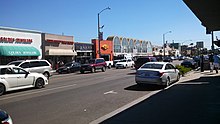
Little India is an Indian enclave centered on Pioneer Boulevard between 183rd and 188th streets in the city of Artesia, California. [1] It is the largest Indian enclave in southern California. [1] As of 2003, approximately 120 shops in the area catered to Indian customers. [2] Though (as of 2004) less than 5% of the city's population was Indian American, Little India contributed approximately a quarter of the city's sales tax receipts. [3]
History
In 1965, the Immigration and Nationality Act abolished restrictive quotas on immigrants from certain regions. [1] During the ensuing increase in immigration from India to the United States, many Indians settled in Los Angeles and Orange Counties. [1] The region's first Indian grocery store was initially established in Hollywood, but it relocated to Artesia in 1970 at the behest of Indians living in Orange County. [1] Other Indian immigrants also settled in Artesia in the 1970s, which was relatively inexpensive at the time. [1] As of 1986, there were about 25 Indian businesses on Pioneer Boulevard; the number had grown to about 90 (or 80% of the retail businesses in the core area) as of 1995. [4] [5]
In the 1980s and 1990s, there were tensions in the community between Indian businesses/residents and non-Indian businesses/residents. [6] [7] Some local politicians proposed signage officially designating the area as "Little India" in 2004, but this proved divisive. [3] [8] Many opposed such signage on the grounds that it would improperly privilege one ethnic group in a diverse area. [3] [9] Ultimately, the area was designated the Artesia International and Cultural Shopping District on street signs. [9]
As of the late 2010s and early 2020s, the area had begun to struggle as a result of competition from Indian businesses elsewhere in the Los Angeles area and on the internet. [4]
Culture
Cultural events held in Little India include celebrations of Indian Independence Day, Diwali, and Navratri. [1] The largest Indian immigrant newspaper in southern California is based in Artesia. [2]
See also
References
- ^ a b c d e f g Lee, Jessica C. (October 8, 2006). "From dairies to samosas and saris". L.A. Times. Retrieved May 10, 2014.
- ^ a b Sandhya Shukla. "New Immigrants, New Forms of Transnational Community: Post-1965 Indian Migrations". In Don T. Nakanishi, ed. (2003). Asian American Politics: Law, Participation, and Policy. James S. Lai. Rowman & Littlefield. p. 189. ISBN 978-0-7425-1850-6.
- ^ a b c Labossiere, Regine (August 26, 2004). "'Little India' Fights for Recognition". L.A. Times. Retrieved May 10, 2014.
- ^ a b Campa, Andrew J. (January 2, 2022). "Little India, already struggling before the pandemic, is at a crossroads". Los Angeles Times.
- ^ Canalis, John (January 15, 1995). "Success of 'Little India' Puts Parking at a Premium, Merchants Say". L.A. Times. Retrieved May 10, 2014.
- ^ Churm, Steven R. (April 6, 1986). "'Little India' : Enterprising Immigrant Merchants Adding Spice to Artesia's Main Street". L.A. Times. Retrieved May 10, 2014.
- ^ Harris, Scott (September 1, 1992). "'Little India' : Ethnicity: A commercial strip in Artesia has evolved into a mecca for the Asian Indian culture. But the influx has drawn complaints in the community". L.A. Times. Retrieved May 10, 2014.
- ^ Fellers, Li (June 10, 2003). "Artesia Split on Little India Proposal". L.A. Times. Retrieved May 10, 2014.
- ^ a b Watanabe, Teresa (November 26, 2005). "Artesia Thinks the World of Itself". L.A. Times. Retrieved May 10, 2014.
Further reading/viewing
- EAT: Los Angeles guide to Little India restaurants
- The Serious Shopping Guide: Los Angeles guide to Little India shopping
- CBS Local guide to Little India
- Wares, Donna (2008-05-17). Great Escapes: Southern California. The Countryman Press. pp. 152–156. ISBN 978-0-88150-779-9.
- Visiting with Huell Howser episode about Little India
- Hamilton, Denise (July 20, 1997). "India Inc". L.A. Times. Retrieved May 10, 2014.
- Del Valley, Alysha (May 27, 2010). "Little India offers SoCal exotic foods, shops". KABC-TV. Archived from the original on May 12, 2014.